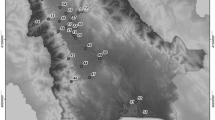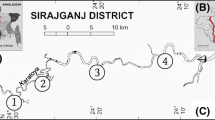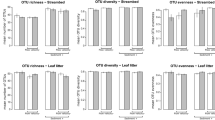Abstract
Stony bottom streams in Italy were sampled in 369 sites in different years, and 174 chironomid species (or species groups) were identified.
The species by sites matrix was submitted to different ordination methods, with the aim of outlining the major factors that are responsible of the observed species composition.
The methods considered were principal component analysis (PCA), detrended correspondence analysis (DCA) and non-metric multidimensional scaling (MDSCAL). These methods assume different models describing the species-responses to the environmental gradients.
PCA gave poor results, the best species ordination was given by MDSCAL. DCA gave results in agreement with MDSCAL. DCA results were useful as a starting point to perform MDSCAL. MDSCAL was performed with different options. At last Procrustean analysis was carried out to have a single fitted configuration, that summarized the results given by the different MDSCAL methods.
All multivariate analyses emphasized that the first ordination axis can be interpreted as a crenonrithron-potamon gradient, probably an oxygen availability and/or a water temperature gradient, whereas the second axis can be considered a water speed gradient, separating lotic from lentic sites.
The 3rd and 4th ordination axes had apparently no ecological meaning.
Separated clusters of species were never evident, so well defined chironomid species assemblages could not be outlined in this analysis.
Similar content being viewed by others
References
CARROL, D., 1986. Some multidimensional scaling and related procedures devised at Bell Laboratories, with ecological applications In: P. Legendre & L. Legendre, eds., Development in Numerical Ecology. NATO ASI Series. Springer Verlag Berlin, p. 65–138.
DIGBY, P.G.N. and R.A. KEMPTON, 1987. Multivariate analysis of ecological communities. Chapman & Hall, London, New York.
FAITH, D.P., P.R. MINCHIN and L. BELBIN, 1987. Compositional dissimilarity as a robust measure of ecological distance. Vegetatio, 69: 57–68.
LELAND, H.V., J.L. CARTER and S.V. FEND, 1986. Use of detrended correspondence analysis to evaluate factors controlling spatial distribution of benthic insects. Hydrobiologia, 132: 113–123.
KANSANEN, P.H., L. PASSIVIRTA and T. VÄYRYNEN, 1990. Ordination analysis and bioindices based on zoobenthos communities used to assess pollution of a lake in southern Finland. Hydrobiologia, 202: 153–170.
MILLER, M.C. and J.R. STOUT, 1989. Variability of macroinvertebrate community composition in an arctic and subarctic stream. Hydrobiologia, 172: 111–127.
MINCHIN, P.R., 1987. An evaluation of the relative robustness of techniques for ecological ordination. Vegetatio, 69: 89–107.
MINCHIN, P.R., 1990. DECODA. Database for Ecological COmmunity DAta. Version 2.01. Copyright 1990 Australian National University. Anutech Pty. Ltd., Canberra.
OLIVER, D.R., 1971. Life history of the Chironomidae. Annual Review of Entomology, 16: 211–230.
PINDER, L.C.V., 1986. Biology of fresh-water Chironomidae. Annual Review of Entomology, 31: 1–23.
ROSSARO, B., 1991a. Chironomids and water temperature. Aquatic Insects, 13: 87–98.
ROSSARO, B., 1991b. Chironomids of stony bottom streams. A detrended correspondence analysis. Archiv für Hydrobiologie, 122: 79–93.
SÆTHER, O.A., 1979. Chironomid Communities as Water Quality Indicators. Holarctic Ecology, 2: 65–74.
TER BRAAK, C.J.F., 1988. CANOCO, a FORTRAN program for canonical community ordination by [sorted] [detrended] [canonical] correspondence analysis and redundancy analysis (version 2.1). Tech. Rep. LWA-88-02, Wageningen, 95 pp.
TER BRAAK, C.J.F., and I.C. PRENTICE, 1988. A theory of gradient analysis. Advances in Ecological Research, 18: 271–317.
THIENEMANN, A., 1954.Chironomus, Leben, Verbreitung und Wirtschaftliche Bedeutung der Chironomiden. Die Binnengewässer, 20: 1–834.
TOLKAMP, H.H., 1980. Organism-substrate relationship in lowland streams. Report Agricultural Univ. Wageningen, 21 p.
Author information
Authors and Affiliations
Rights and permissions
About this article
Cite this article
Rossaro, B. Ordination methods and chironomid species in stony bottom streams. Netherlands Journal of Aquatic Ecology 26, 447–456 (1992). https://doi.org/10.1007/BF02255274
Issue Date:
DOI: https://doi.org/10.1007/BF02255274




